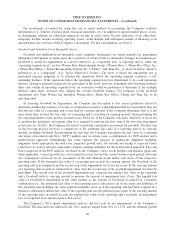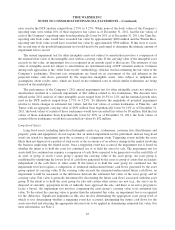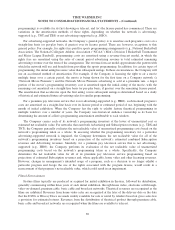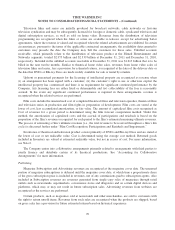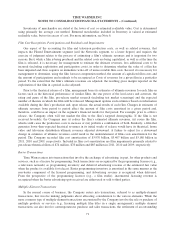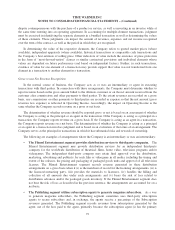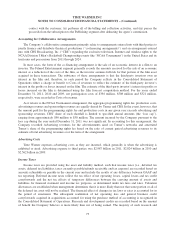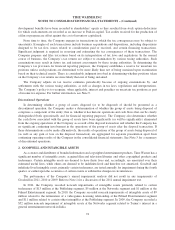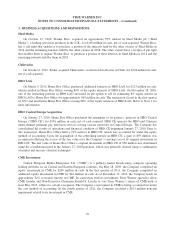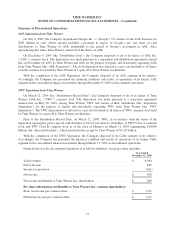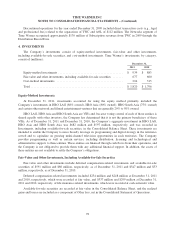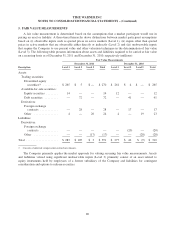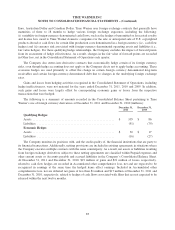Time Magazine 2011 Annual Report Download - page 88
Download and view the complete annual report
Please find page 88 of the 2011 Time Magazine annual report below. You can navigate through the pages in the report by either clicking on the pages listed below, or by using the keyword search tool below to find specific information within the annual report.TIME WARNER INC.
NOTES TO CONSOLIDATED FINANCIAL STATEMENTS – (Continued)
development benefits have been recorded to shareholders’ equity as they resulted from stock option deductions
for which such amounts are recorded as an increase to Paid-in-capital. Tax credits received for the production of
a film or program are offset against the cost of inventory capitalized.
From time to time, the Company engages in transactions in which the tax consequences may be subject to
uncertainty. Examples of such transactions include business acquisitions and dispositions, including dispositions
designed to be tax free, issues related to consideration paid or received, and certain financing transactions.
Significant judgment is required in assessing and estimating the tax consequences of these transactions. The
Company prepares and files tax returns based on its interpretation of tax laws and regulations. In the normal
course of business, the Company’s tax returns are subject to examination by various taxing authorities. Such
examinations may result in future tax and interest assessments by these taxing authorities. In determining the
Company’s tax provision for financial reporting purposes, the Company establishes a reserve for uncertain tax
positions unless such positions are determined to be more likely than not of being sustained upon examination
based on their technical merits. There is considerable judgment involved in determining whether positions taken
on the Company’s tax returns are more likely than not of being sustained.
The Company adjusts its tax reserve estimates periodically because of ongoing examinations by, and
settlements with, the various taxing authorities, as well as changes in tax laws, regulations and interpretations.
The Company’s policy is to recognize, when applicable, interest and penalties on uncertain tax positions as part
of income tax expense. For further information, see Note 9.
Discontinued Operations
In determining whether a group of assets disposed (or to be disposed) of should be presented as a
discontinued operation, the Company makes a determination of whether the group of assets being disposed of
comprises a component of the entity; that is, whether it has historic operations and cash flows that can be clearly
distinguished (both operationally and for financial reporting purposes). The Company also determines whether
the cash flows associated with the group of assets have been significantly (or will be significantly) eliminated
from the ongoing operations of the Company as a result of the disposal transaction and whether the Company has
no significant continuing involvement in the operations of the group of assets after the disposal transaction. If
these determinations can be made affirmatively, the results of operations of the group of assets being disposed of
(as well as any gain or loss on the disposal transaction) are aggregated for separate presentation apart from
continuing operating results of the Company in the consolidated financial statements. See Note 3 for a summary
of discontinued operations.
2. GOODWILL AND INTANGIBLE ASSETS
As a creator and distributor of branded information and copyrighted entertainment products, Time Warner has a
significant number of intangible assets, acquired film and television libraries and other copyrighted products and
tradenames. Certain intangible assets are deemed to have finite lives and, accordingly, are amortized over their
estimated useful lives, while others are deemed to be indefinite-lived and therefore not amortized. Goodwill and
indefinite-lived intangible assets, primarily certain tradenames, are tested annually for impairment during the fourth
quarter, or earlier upon the occurrence of certain events or substantive changes in circumstances.
The performance of the Company’s annual impairment analysis did not result in any impairments of
Goodwill in 2011, 2010 or 2009. Refer to Note 1 for a discussion of the 2011 annual impairment test.
In 2011, the Company recorded noncash impairments of intangible assets primarily related to certain
tradenames of $13 million at the Publishing segment, $5 million at the Networks segment and $1 million at the
Filmed Entertainment segment. In 2010, the Company recorded noncash impairments of intangible assets of $9
million related to the termination of a videogames licensing relationship at the Filmed Entertainment segment
and $11 million related to certain other intangibles at the Publishing segment. In 2009, the Company recorded a
$52 million noncash impairment of intangible assets at the Networks segment related to Turner’s interest in a
general entertainment network in India.
74




